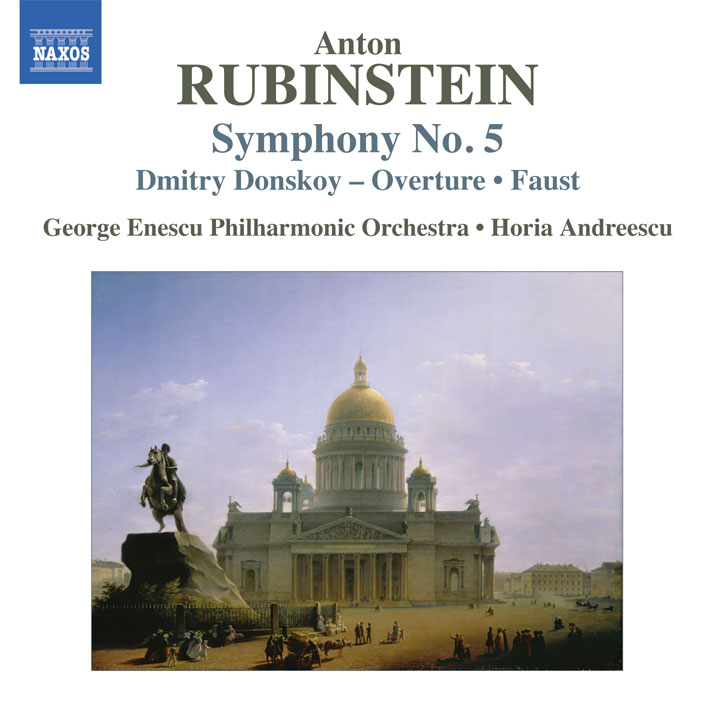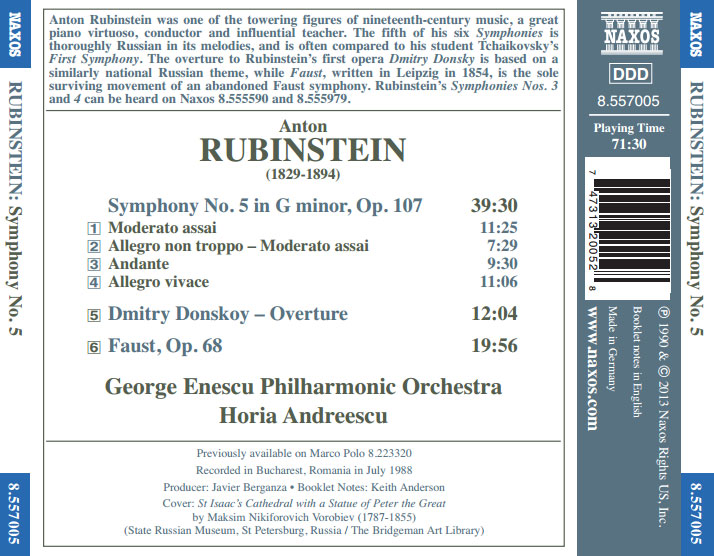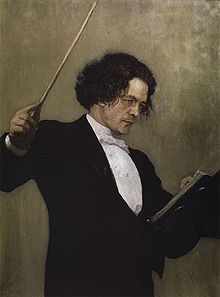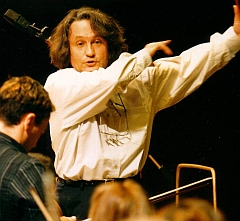Share This
Album at a Glance
Release date: 2013-07-30
Tags
Related Posts
- Music for Brass Septet, Vol. 2 - Instrumental suites from operas by Rameau, Blow, Purcell & Handel / Septura
- Franz Ignaz Beck (1734-1809): Symphonies Op. 4, Nos. 1-3, Op. 3, No. 6 / Czech CO, Pardubice
- Louis Glass (1864-1936): Complete Symphonies, Vol. 1 / Staatsorchester Rheinische Philharmonie; Daniel Raiskin
- William Wallace: Creation Symphony; Pelléas and Mélisande; Prelude to The Eumenides / Brabbins, BBC Scottish SO
Anton Rubinstein: Symphony No. 5; Dmitry Donskoy, overture; Faust, Op. 68
Posted by Paul Ballyk on Aug 26, 2013 in Romantic | 0 comments
Recommendation
Overview
Artists
Purchase
Recommendation
Russian composer Anton Rubinstein (1829-1894) wrote six symphonies, the Second, known as The Ocean, being the most frequently performed and recorded. His Symphony No. 5 in G minor appears far less commonly. Aside from this Naxos CD, there exists only one other currently active version in the catalog. This recording itself, performed by the George Enescu Philharmonic under Horia Andreescu, is the reissue of a release that originally appeared on Marco Polo in 1988. I can find no evidence that any other version was ever made commercially available.
Rubinstein's place in music history is better established as a legendary pianist than as a composer. A player of reputedly staggering ability, he was a child prodigy who matured to become one of the most famous piano virtuosos of his time. In his biography, Sergei Rachmaninov said of Rubinstein's art "It was not so much his magnificent technique that held one spellbound as the profound, spiritually refined musicianship, which spoke from every note and every bar he played." Rubinstein was also an influential educator. As founder of the St. Petersburg Conservatory in 1862, he has influenced the art of countless musicians from Tchaikovsky to this day. As a composer, he wrote prodigiously in most every genre from solo piano and chamber music, concertos and orchestral works (six symphonies) to lieder, oratorio and opera (twenty of them!).
The Fifth Symphony is scored for a rather light-weight orchestra. In addition to strings and timpani, all of the winds and brass are represented in pairs, with the exception of the horns, Rubinstein calling for four. That's it. There are no color instruments, such as cor anglais, piccolo, or conta-anything and no low brass at all.
Rubinstein's early studies were in Berlin, which had a profound influence on his music. He adopted an early-romantic Germanic style that is more Schumann and Mendelssohn than Balakirev and Mussorgsky. But this Fifth is Rubinstein's most Russian sounding symphony; you'll be thinking Tchaikovsky from the opening measures. The sample we have for you to listen to is the opening seven minutes or so of the fourth movement, and you can hear various excerpts from the symphony in the video below.
Russian composer Anton Rubinstein (1829-1894) wrote six symphonies, the Second, known as The Ocean, being the most frequently performed and recorded. His Symphony No. 5 in G minor appears far less commonly. Aside from this Naxos CD, there exists only one other currently active version in the catalog. This recording itself, performed by the George Enescu Philharmonic under Horia Andreescu, is the reissue of a release that originally appeared on Marco Polo in 1988. I can find no evidence that any other version was ever made commercially available.
Rubinstein's place in music history is better established as a legendary pianist than as a composer. A player of reputedly staggering ability, he was a child prodigy who matured to become one of the most famous piano virtuosos of his time. In his biography, Sergei Rachmaninov said of Rubinstein's art "It was not so much his magnificent technique that held one spellbound as the profound, spiritually refined musicianship, which spoke from every note and every bar he played." Rubinstein was also an influential educator. As founder of the St. Petersburg Conservatory in 1862, he has influenced the art of countless musicians from Tchaikovsky to this day. As a composer, he wrote prodigiously in most every genre from solo piano and chamber music, concertos and orchestral works (six symphonies) to lieder, oratorio and opera (twenty of them!).
The Fifth Symphony is scored for a rather light-weight orchestra. In addition to strings and timpani, all of the winds and brass are represented in pairs, with the exception of the horns, Rubinstein calling for four. That's it. There are no color instruments, such as cor anglais, piccolo, or conta-anything and no low brass at all.
Rubinstein's early studies were in Berlin, which had a profound influence on his music. He adopted an early-romantic Germanic style that is more Schumann and Mendelssohn than Balakirev and Mussorgsky. But this Fifth is Rubinstein's most Russian sounding symphony; you'll be thinking Tchaikovsky from the opening measures. The sample we have for you to listen to is the opening seven minutes or so of the fourth movement, and you can hear various excerpts from the symphony in the video below.
Album Overview
Anton Rubinstein was one of the towering figures of nineteenth-century music, a great piano virtuoso, conductor and influential teacher. The fifth of his six Symphonies is thoroughly Russian in its melodies, and is often compared to his student Tchaikovsky's First Symphony. The overture to Rubinstein's first opera Dmitry Donsky is based on a similarly national Russian theme, while Faust, written in Leipzig in 1854, is the sole surviving movement of an abandoned Faust symphony. Rubinstein's Symphonies Nos. 3 and 4 can be heard on Naxos 8.555590 and 8.555979.
Source: Naxos
Anton Rubinstein was one of the towering figures of nineteenth-century music, a great piano virtuoso, conductor and influential teacher. The fifth of his six Symphonies is thoroughly Russian in its melodies, and is often compared to his student Tchaikovsky's First Symphony. The overture to Rubinstein's first opera Dmitry Donsky is based on a similarly national Russian theme, while Faust, written in Leipzig in 1854, is the sole surviving movement of an abandoned Faust symphony. Rubinstein's Symphonies Nos. 3 and 4 can be heard on Naxos 8.555590 and 8.555979.
Source: Naxos
![]() About Paul Ballyk
About Paul Ballyk
all about Paul
Twitter •
| Thinking about purchasing this album?
Follow this link for more album details or to make the purchase. Buy it now |
“Not just recommended. Guaranteed.”
We stand behind every album featured on Expedition Audio. Our objective is to take the monetary risk out of music exploration. If you order this album from HBDirect.com and do not like it you can return it for a refund.
More from this same recording provided courtesy of the Naxo label"










